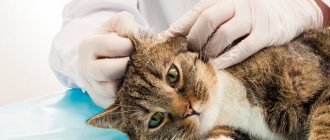Otodectosis is a common disease in animals. When faced with a disease, pet owners often do not appreciate its scale, so treatment is started in advanced cases. In order for the therapy to proceed without complications, you need to understand what otodectosis in cats is. The sooner a person notices the first signs of illness in a pet, the faster he can cure it.
Features of the disease
Otodecosis in cats is caused by the microscopic (about ½ mm) insect Otodectes cynotus.
The parasite has a whitish oval body and jointed limbs. It loves moisture and warmth, so it parasitizes inside the animal’s ear canal, feeding on skin scales, blood, and lymph. Outside the host's body, the tick can live for about two months. In most cases, the parasite affects both ears of the cat. The likelihood of infection is especially high during the warm and humid seasons - spring and early autumn. The risk group includes kittens under one year old and weakened animals. It may take several years from the moment of infection to obvious signs of the presence of a tick. The disease manifests itself especially clearly when a bacterial infection is added to the skin damage by the parasite. Due to itching and pain, an exhausted pet cannot sleep or eat.
What is otodectosis
The ear mite in cats is a small parasite with a body size of about 0.5 mm with the Latin name Otodectes cynotus. It has an oval white body and legs with several joints. They usually live in warm, humid environments. When it comes into contact with an animal, it prefers to settle in the ear canal. Here they eat the skin, feed on lymph and blood. In an open environment, a tick can live up to two months.
Question to the expert
If there is an ear mite on one side, will it affect the cat's other ear?
As a rule, otodectosis affects both ears of a cat. This happens especially often in spring and autumn.
Briefly about the pathogen
Ear mites in cats are arthropods, not insects.
The body length varies from 0.2 to 0.6 mm, which is comparable to a semolina grain. The body has an oval shape and is yellow in color. It is distinguished by the presence of eight segmented legs and two pedipalps (legs with tentacles). This parasite is not transmitted from cats to humans and does not pose any threat to them. Only animals suffer from it. Other pets - rabbits, hamsters, dogs - can become infected from an infected carrier.
The risk group includes pets with weakened immune systems (old ones who have had the disease), as well as small kittens whose protective functions of the body have not yet developed properly. In the initial stages, otodectosis causes itching and redness. As the disease progresses, it can cause complete hearing loss and even death of the animal.
An accurate diagnosis is made based on examination only by veterinarians, and based on this, appropriate treatment is prescribed.
How does infection occur?
The life cycle of a tick depends on the condition of the cat. Pets become infected with this parasite in the external environment. In warm weather, ear mites remain active for a long time and can even enter the body from clothing or the sole of a person’s shoes. Most often, the parasite infects animals under one year of age.
The routes of infection are:
- cat household items (comb, carrier and other accessories);
- human clothing;
- flies or fleas that can carry parasites;
- contact with wild or stray animals.
Once on the cat's body, the tick penetrates the ear, causing microscopic damage to the skin. The vital activity of the parasite causes irritation and pain. Then swelling and tissue death occurs. If measures are not taken in time and the course of the disease begins, rupture of the eardrums and even damage to the meninges may occur. Such complications pose a direct threat to the life of the animal.
Useful to read: How to choose a flea collar for cats
The danger of ear mites for cats
Ear mites feed on skin particles, causing severe damage to the skin. If left untreated, your cat may develop serious health problems:
- unbearable itching causes constant scratching of the ears, which leads to damage to the capillaries and the appearance of extensive hematomas;
- Bacterial and fungal infections penetrate into places where the skin is damaged, the inflammatory process begins, the ear tissues swell, redden, and fester;
- gradually the inflammation spreads to the eardrum and to the inner ear - otitis media and myringitis develop.
Further delay with therapy will lead to weakening and then loss of hearing. Pain and itching interfere with normal rest and eating. The animal becomes irritated, nervous, and aggressive. Over time, inflammation can penetrate the membranes of the brain, resulting in death.
Symptoms of otodectosis
To determine whether a pet has been infected with a parasite, it is necessary to conduct a full diagnosis of its behavior and condition as a whole.
The first signs of otodectosis are:
- Anxiety. Due to the incessant itching, the cat may begin to behave aggressively.
- Scabies. The animal tries to ease the discomfort. It will rub against hard surfaces, shake its head, or scratch its ear with its paw. The danger is that as a result, scratches form on the inside of the ear. Subsequently, they become infected and begin to fester. This should not be allowed, because it can lead to the death of the pet.
- Swelling. Associated with a large accumulation of blood in the areas affected by the tick.
- Exudate - liquid discharge on damaged areas. Subsequently, mixing with particles of the epidermis and waste products of the insect, they transform into brown scabs. Often accompanied by otitis media.
- Lethargy of the animal associated with an increase in body temperature.
- A crust in the area of the ear canal, resulting in the formation of plugs of dried sulfur.
- Fur glued together with pus.
- A specific unpleasant odor that can spread to the affected area.
- Hearing impairment in later stages.
- “Bowheadedness.” The cat constantly turns its head 120 degrees so that the affected ear is located below.
Important: if you find that your pet periodically has nervous attacks, contact a specialist immediately. In this case, there is a high probability that the pathogen will penetrate into the inner ear and begin the process of inflammation of the meninges.
How can a pet become infected?
A cat can pick up ear mites on the street, through contact with sick animals or in walking areas. Most stray cats suffer from otodecosis, so letting your pet roam freely is fraught with negative consequences.
The parasite can be picked up on shoes by the owner while accidentally walking in places where stray cats like to gather. An owner can bring ear mites home after petting someone else's pet with otodecosis. In addition, there is a high probability of disease in homes where there have already been (or are) cases of the disease in other animals.
Kittens can become infected at birth from a mother who is a carrier of ear mites. Infection through bedding, carpets, household furniture or dishes is possible.
Routes of infection
Infection with ear mites most often occurs from a stray sick animal. That is, a pet can get sick from a cat that is a carrier of the disease. During infection, the animal usually has a weak immune system.
Possible routes of infection:
- pet care items (comb, carrier, clothes);
- owner's clothes and shoes;
- fleas, flies;
- wild animals (foxes, raccoons).
Either the tick itself or its eggs get on the cat's skin or fur. First of all, the parasite penetrates the ear, injuring the skin. The waste products of arthropods lead to inflammation and pain in the pet. Afterwards, swelling of the blood vessels develops. The ear swells, exudate separates, which after drying turns into brown crusts. Subsequently, the layering of crusts forms plugs. If left untreated, the pressure of the plugs on the eardrum can cause it to rupture. Unfortunately, there is no vaccination against ticks.
Symptoms of ear mites in cats
There are practically no symptoms of ear mites in cats at the onset of the disease. You should take your pet to a veterinarian if the following signs of illness are detected:
- frequent scratching of the ears, leading to bruising;
- head shaking, restlessness;
- discharge from the ear canal of liquid, stuck together pieces of sulfur of a dirty gray or dirty brown color;
- glued fur on the ears;
- hair loss in the ear area;
- purulent ulcers on the outer ear;
- swelling and redness of the ears;
- unpleasant odor;
- the animal walks with its head bowed.
You should suspect odecosis if your cat periodically shakes its head and scratches its ears. Discharge, odor and other signs appear later, when the disease takes an advanced form.
Symptoms and diagnosis of the disease
Ear scabies is a disease caused by mites. Arthropod parasites settle in the hearing organs of a pet, injure delicate skin, and their saliva and feces activate irritation and itching. Insects live only on animals, so people do not become infected.
Arthropods parasitize the eardrum and external auditory canals. They prefer to feed on lymph, blood and skin particles. Like all pests, ticks are very tenacious - they survive without a host on a starvation diet for two weeks. Signs of the disease depend on the stage of its development:
- First 14 days. The pet shakes its head and constantly scratches its ear with its paws.
- From 15 to 20 days. To reduce the intensity of itching, the cat rubs against walls, rough objects and corners. At the base of the passage and on the inner walls of the hearing organs, abrasions, scratches and dark, coffee-like discharge appear. An unpleasant odor appears from the ear, the animal loses its appetite and tilts its head at an angle of 120 degrees.
- The period from the third to the fifth week. The cat has a high body temperature, sometimes there are seizures, convulsions and tremors of the limbs. The swelling is visible to the naked eye, and when you palpate it, a squelching sound is heard. Sticky mucus appears on the fur.
At home, otodectosis in cats, the symptoms and treatment of which are interrelated, can only be diagnosed at the second or third stage. The initial stage takes place in a hidden form and is not always definable. If suspicions arise, veterinarians recommend carefully running a cotton swab along the inner passage of the ear. The contents are shaken onto a black cloth, illuminated with a lamp and examined under a powerful magnifying glass. White dots spreading in different directions are ear mites.
It is much easier to diagnose a disease in a hospital than at home. The specialist carefully examines the pet, identifies primary signs of otodectosis and performs tests. If the animal’s condition allows it, then it undergoes an otoscopy - an instrumental examination of the surface of the auricle and membrane. A positive result and the overall clinical picture influence the choice of therapy.
Diagnosis of otodecosis
Even if there are seemingly obvious signs of ear mites, the cat should be shown to a veterinarian. Similar symptoms may appear with dermatoses, lichen, fungal and bacterial infections. In addition, there is another type of external microscopic parasite that lives on the ears of cats. Therefore, before starting treatment, a diagnosis is required.
The diagnosis is made based on examination and microscopic examination of scrapings from the surface of the auricle. Under a microscope, the doctor will quickly identify the parasite and prescribe appropriate treatment.
If laboratory diagnostics are not possible, you can try the home method. To do this you will need a black sheet of paper and a magnifying glass. You need to take a little discharge from the inner surface of your pet’s ear and smear it on paper. If there is a parasite, then on the leaf it looks like a moving whitish dot.
Medicines for ticks
Medicines for ear mites are available in the form of ointments or drops. Among the large assortment, it is difficult to choose the right remedy on your own: you should take into account the degree of damage, the presence of concomitant infections, and the age of the animal. In the treatment of otodecosis, the medications listed below are most often used.
A drug
Course of treatment, dosage
Note
Amidel
The gel is applied to the cleaned surface of the ear 3-5 times at intervals of one week.
Do not use on kittens under 2 months of age or on cats during pregnancy.
Otoferonol Gold
Apply twice with a break a week. Dosage – 3 drops in each ear.
Do not use on kittens under two months of age or pregnant cats. The product destroys the parasite and has an anti-inflammatory effect.
Aversectin ointment
Apply 2-4 times, interval – 7 days.
Do not apply the ointment to kittens under 2 months of age or during pregnancy.
Amitrazine
The course of treatment includes 4-5 procedures. The breaks between instillations are three days. Dosage – ½ ml in one ear.
Not for use in pregnant cats.
Dekta
Ear drops are used every five days, 4-5 drops once. A total of 2-4 procedures are required.
The product is not suitable for babies under 30 days old and pregnant cats. The composition includes an antibacterial component.
In difficult situations, the veterinarian will prescribe injections or antibacterial drugs.
How to treat the ears
You need to treat the ears of your furry pet as follows.
- Before using the medicine, the cat's ears are cleaned of accumulated plaque. This will allow the medicine to penetrate deeper. For cleansing, use special solutions or regular vegetable oil. The surface of the ear is wiped with a cotton pad or a piece of bandage soaked in the solution. Hydrogen peroxide or other agents should not be instilled into the ear canal!
- Apply ointment or drops to the clean surface of the auricle in the amount specified in the instructions for the drug.
- To ensure that the medicine is distributed evenly, the ear needs to be massaged a little.
- If drops are used, the cat's head should be supported to prevent shaking and the medicine being thrown out.
- In conclusion, it is recommended to wipe the auricle again with a cotton pad soaked in the same product.
Attention: it is not recommended to use cotton swabs to treat the ears of an animal - the likelihood of injury to the ear canal and infection in the deep parts of the ear increases.
How to properly clean a cat's ears
To remove ticks, you need to know how to properly clean your cat's ears.
- To carry out this procedure, use a cotton pad that is soaked in lotion.
- After which they are carefully passed along the visible surface of the auditory canal.
- Next, the ear is pinched and massaged for several seconds.
- Then you need to clean the surface of the sink with a clean cotton pad.
Such manipulations are carried out several times until the inner surface is completely cleared of sulfur secretions and waste products of pests. Next, you can begin applying medications.
On a note!
To prevent the development of the disease, experts recommend cleaning both ears, regardless of which one is infected with mites.
Concomitant therapy
When treating ear mites, you need to keep in mind that the parasite can spread to the cat’s body, so in parallel with treating the ears, antiparasitic procedures for the whole body should be carried out. To do this, just apply a few drops of a special preparation to the pet’s scruff or treat it with a spray. Among the sprays, the most popular are Frontline and Cyodrin. It is imperative to ensure that the animal does not lick its fur for a certain period of time.
You should also take care of your furry pet’s immune system. The stronger the immune system, the faster the recovery, and the greater the chance of avoiding re-infection. A cat's diet should contain a large amount of vitamins and be varied. You can add ready-made vitamin complexes to the food. It is also recommended to carry out a course of therapy with drugs that enhance the body’s defenses - Gamavit, Tentravit.
Prevention
The appearance of ticks is a case more typical for “walking” animals. However, even if your pet has never left the walls of the house, this does not guarantee that you will not encounter the disease. The reason may be the use of other people's carriers, bedding or toys.
Preventive measures include:
- regular ear cleaning (Bars Lotion, Otifri, Otodepin are excellent);
- preventing contact with stray animals;
- periodic disinfection of paraphernalia (beds, bowls, etc.);
- strengthening the immune system (it is recommended to include foods high in microelements and vitamins);
- the use of special drugs during the period of parasite activity.
Give your furry friends more attention, which is expressed not only in affection and feeding. Do not forget that they, like any living organism, require care. After all, when the animal receives it at the proper level and is in a calm state, then the owner is happy. Good luck!
Treatment with folk remedies
Treatment with folk remedies is permissible only at the very beginning of the development of the disease. In case of obvious symptoms of ear mites, they are suitable only as auxiliary methods. In addition, folk recipes can be used to prevent odecosis.
One of the most common cat ear care products is green tea. Its strong infusion acts as an antiseptic. After the brew has cooled, soak a cotton pad in it and wipe the external auditory canal. The decoction can be used both to cleanse the ears before instilling drops, and for regular care.
Hydrogen peroxide is used in the same way. It cannot be instilled into the ears; it is only allowed to moisten the crusts and wipe the surface of the cartilage.
Vegetable oils are widely used to clean the ears. Any oil will do: olive, sunflower, vaseline, camphor-based. Oils are not suitable for preventing the disease, but they can soften and remove scabs. After applying the oil, the animal’s ears should be wiped with a clean disk so that the oil film does not interfere with the absorption of the medicine.
Sometimes it is recommended to use garlic pulp or juice to combat ear mites in cats, but its irritant properties in this case will be stronger than its antiseptic properties. In addition, garlic will still not be able to destroy the parasite, so this remedy should be abandoned.
Treatment methods and prognosis
If an ear mite is detected in a cat, treatment is started immediately. If several animals live in the house, then everyone is treated for parasites, since otodectosis is very quickly transmitted from one animal to another.
Treatment plan for ear mites in cats:
- First, the animal's ears are freed of contents - waste products of parasites, particles of dead skin and secretions.
- After cleaning, antiparasitic drugs are injected into the sinks, which will be prescribed by the veterinarian.
- In case of otodectosis, both ears must be treated, even if one of them is clean and seems healthy.
- The most effective is complex treatment, which uses not only ear medications, but also means for treating other parts of the body - acaricidal sprays, powders and solutions.
- Parasites greatly weaken the immune system, so it needs to be supported. During treatment, it is advisable to give your pet a cat vitamin-mineral complex.
If symptoms are detected in time and treatment is started immediately, the prognosis for otodectosis is favorable. The main thing is to follow the veterinarian’s recommendations and not stop therapy prematurely.
Cleaning the ears before using acaricides
To clean your cat's ears, you need to prepare hydrogen peroxide or chlorhexidine solution, sponges and cotton swabs. The cat will have to be restrained as it will feel pain during the procedure.
- First, a few drops of disinfectant are dripped into the ear.
- Then the shell is gently squeezed with your fingers and massaged so that the composition is distributed inside.
- Next, carefully remove the brown mass, soggy crusts and purulent discharge, if any, with cotton pads. You will need at least 6-8 sponges for each ear.
- Hard-to-reach places are treated with a cotton swab.
Attention! It is important to be very careful when cleaning your ears. Do not insert the cotton swab deeply so as not to damage the membrane.
At the end of the procedure, a medicine against ear mites is injected into each ear canal of the cat, after which the shells are massaged again to better distribute the antiparasitic composition.
After treating the ears with the drug, a collar is put on the pet so that it cannot lick off the medicinal composition. After a couple of hours it can be removed.
Effective preparations for topical use
Vet pharmacies offer a wide range of acaricidal agents for treating ear mites in cats at home. They are available in the form of drops, gel, ointment, spray.
Amitrazine drops
An acaricidal drug in the form of an oil liniment with antiparasitic, analgesic and anti-inflammatory effects. It is necessary to inject 0.5 ml of the product into both ears once every 3 days. The course consists of 5–7 procedures.
Amidel gel
A drug based on amitraz. Quickly removes ticks and their larvae. The gel contains lidocaine, which helps eliminate pain and itching. Methyluracil is another component of the drug, which accelerates local metabolism in tissues, promotes rapid wound regeneration and relieves inflammation.
Dosage – 0.5 ml per 1 kg of cat’s weight. The gel is injected into the ear, the shell is squeezed near the base and massaged for 1-2 minutes so that the medicine is distributed inside. Treatment is carried out 3 to 5 times with an interval of 3–4 days.
Aversectin ointment
An effective drug to combat ear mites in cats and dogs. The active ingredient is aversectin C, which destroys both larvae and adults. To get rid of parasites, 2 or 3 treatments are enough, the interval between them is 5–7 days. The ointment is easier to apply if you hold the bottle in warm water before use.
Aurikan
The drug in the form of drops is recommended for use in cases of otodectosis, which is complicated by a bacterial infection. The active ingredient is diazinon, which is active against mature ticks and larvae.
Aurican also contains prednisolone, a synthetic glucocorticosteroid with anti-inflammatory and antiallergic effects. Another component of the drug, hexamidine diisethionate, is an antiseptic; it destroys pathogenic bacteria. The drops also contain an anesthetic.
Aurican against ear mites is used once a day for 7 days, then treatment is done twice a week for a month. Dosage for cats – 5 drops of medicine in each ear.
Drops of Stronghold
The active component of the drug Stronghold is selamectin, which destroys adult ticks, their larvae and eggs. The drops are injected into the ear canal once, but first it must be cleared of scabs and exudate. After a month, it is necessary to repeat the treatment. The dosage is calculated depending on age.
For cats whose weight does not exceed 2.5 kg – 0.25 ml. If the animal’s weight is 2.6–7.5 kg, then the dosage is increased to 0.75 ml.
Frontline Combo
Fipronil based drops. Effectively fight ear mites in cats, dogs, and ferrets. The drug is used once. You need to inject 5 drops of the product into each ear. The therapeutic course can be repeated after 28 days if necessary.
Leopard
Ear drops based on diazinon, an organophosphorus compound with enteric contact action. It has pronounced insecticidal and acaricidal activity against arthropods, including pathogens of otodectosis.
The drug contains prednisolone, a glucocorticosteroid. It helps relieve swelling and inflammation, as well as eliminate itching. Dosage for cats: 3 drops in each ear. To destroy parasites, two procedures with an interval of 1 week are enough.
Anandin plus
Anandin plus drops are an acaricidal drug based on synthetic pyrethroids, which includes an antimicrobial and anti-inflammatory component. This remedy is recommended for the fight against ear scabies in cats complicated by otitis media. Dosage – 3 drops in the ear. Treatment regimen: 2 treatments with an interval of 5–7 days.
Injections against ear mites
For the comprehensive treatment of cats against ear mites, acaricidal preparations are used in the form of injections:
- Ivermectin. The drug is injected under the skin in the withers area 2 or 3 times every 10 or 14 days. The dose for a cat is 0.3 ml/kg body weight.
- Otodectin. The product is used to treat fleas, ticks and various helminthiases. For otodectosis, the drug is administered subcutaneously 2 times every 10 days. Dosage for cats: 0.2 ml/kg animal weight.
In case of complicated otodectosis, additional therapy with the use of antibiotics and immunostimulants is necessary.
Folk remedies for ear mites in cats
Some cat owners try to remove ear mites using folk remedies. They use vegetable oil, garlic juice and pulp, or strong green tea. However, their actions only make the situation worse.
Parasites continue to multiply in the ear canals, and the cat develops an inflammatory process. Folk remedies are ineffective against arthropods, and some of them cause even greater harm to the health of the animal. For example, garlic can cause skin irritation or allergies.
Main rules of treatment
When treating odecosis at home, you need to follow a number of recommendations.
- If there are several animals in the house, all of them need to be treated for ticks, regardless of the presence or absence of the parasite. It is better for kittens and cats to use spray products during pregnancy.
- Be sure to treat your pet's bedding with an antiparasitic agent. If possible, it should be boiled.
- Until the product applied to the withers has dried, it is important to monitor the cat, preventing it from licking itself.
- Since recovery depends on the state of the immune system, it is necessary to provide your pet with a balanced diet and include vitamin complexes in it. Periodically take the animal out into the fresh air.
- Ear mites can also live on furniture, carpets, floor cracks and other objects, so wet cleaning should be done by adding an acaricidal agent to the water.
- Do not use ethyl alcohol-based products to clean your cat's ears.
How can an animal become infected with ear mites?
The source of the disease is infectious animals. Close contact is required for the parasites to penetrate the cat's fur. Along it they spread to the outer ear area, where the reproduction cycle begins. Without a host organism, the tick quickly dies in environmental conditions. He needs no more than 2 months for this.
Scabies in cats: mite, treatment at home
Examination of a cat with ear mites
Both an adult and a kitten can become infected. In addition to close contact, ear mites in cats can be transmitted through contact with the following objects:
- combs;
- animal houses;
- toys;
- not sterile instruments from veterinarians;
- carrying;
- a person who has carried the parasite on clothes, hands, shoes;
- an insect that carries microscopic eggs or young.
The reproduction and life cycle of ticks begins in the spring. It is during this period of time that it is dangerous to take a cat outside, as it comes into contact with other individuals. Ticks can even spread through grass after an infected animal passes through it.
Attention! Ear scabies are more common in young individuals.
Cats do not always become infected. This is preceded by a decrease in the function of the immune system and the presence of a recent illness.
Are there strong remedies for ear mites?
There is a stronger way to get rid of ear mites than ointments and drops. These are injections. Their distinctive feature is that you can get rid of all parasitic insects at the same time (if they are present). At the same time, the use of this method is fraught with negative consequences - the active substances are toxic to the cat’s body. Their use can provoke allergies, baldness, dermatoses and other complications. The use of such drugs is contraindicated during pregnancy and for kittens.
Danger to humans and other animals
Many owners fear that ear mites are dangerous to humans. However, otodectosis is not transmitted to people or even small children. But for other pets the disease is dangerous, as it is easily and quickly transmitted.
It is worth remembering that a person can become a carrier of parasites without getting sick. Therefore, it is easier to keep the house clean and care for your pet than to treat it later.
How to prevent otodecosis
In most cases, tick damage to a cat's ears can be prevented. To do this, you should adhere to the following preventive measures:
- periodically inspect your pet’s ears for scratching, redness, swelling, and scabs;
- regularly clean the external auditory canal;
- do not allow communication with unfamiliar animals;
- strengthen the cat's immune system.
Paying close attention to your pet and promptly seeing a doctor will help avoid health problems.
Treatment of a kitten or pregnant cat
The insidiousness of the disease is that otodectosis often occurs in kittens. But, judging by the statistics, animals of any gender and age get sick. Whether it is a small kitten, a pregnant cat or an adult cat, the disease makes no difference.
Kittens can become infected with otodectosis from their mother.
In case of pregnancy or young age, drugs are used to treat otodectosis in cats, which are prescribed in the instructions for use.











